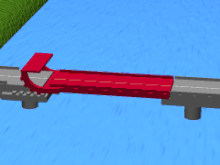Drawbridge

A drawbridge is a bridge that can be moved in order to stop or allow passage across it. They were often built as part of medieval castles which had moats.
Modern drawbridges are often built across large, busy waterways. They can be lifted to allow large ships to pass or lowered to allow land vehicles or pedestrians to cross.
History[change | change source]
The drawbridge has a rich history spanning millennia, with its origins rooted in fortifications where it controlled entry. Historians trace its beginnings to ancient Egypt some four thousand years ago, with the Chaldean kingdom in the Middle East erecting another around three millennia prior. However, drawbridges only became commonplace during the European Middle Ages.
Leonardo da Vinci is often credited with designing a prevalent style of drawbridge in the late fifteenth century. He envisioned various types and even crafted scale models. Not until the middle of the nineteenth century did the modern drawbridge emerge, coinciding with the widespread availability of steel. The advent of steel beams revolutionized drawbridge construction, offering a combination of lightness, strength, and durability previously unattainable.
Types of Drawbridge[change | change source]
The Bascule Drawbridgeː The bascule drawbridge stands as the oldest documented form of its kind. Comprising one or more panels, it transitions from a horizontal to a vertical orientation aided by a pulley system and counterweights. When closed, multiple panels align horizontally.[1]
Derived from the French language, "bascule" translates to seesaw. These bridges are often favored for their ability to fully clear waterways for swiftly moving vessels. They also accommodate smaller boats, even when not fully open. In terms of safety, the bascule style shines when closed, offering robust protection. However, during operation, it becomes susceptible to high wind loads that may cause damage. Moreover, the machinery required for its control must be notably sturdy compared to other drawbridge styles.
The Line Drawbridgeː The line drawbridge, a lesser-known but intriguing variation, operates on a unique principle. Instead of relying on traditional panels or leaves, it employs a mechanism of ropes or cables stretched across the waterway. When activated, these ropes are pulled taut, forming a temporary pathway for crossing. Though not as common as other types, the line drawbridge offers simplicity and versatility. Its minimalist design allows for rapid deployment and minimal maintenance, making it a practical solution in certain settings. However, its reliance on tension means it may not withstand heavy loads or adverse weather conditions as effectively as more robust designs. Despite its limitations, the line drawbridge serves as a testament to human ingenuity in devising innovative solutions to age-old challenges of transportation and access.
The Swing Drawbridgeː A swing bridge, also known as a pivot bridge or turn bridge, represents a movable low bridge design capable of spanning long distances. Typically, its main structural support rests near the center of gravity along a vertical axis. In its closed configuration, a swing bridge facilitates traffic flow over the waterway. However, when a ship requires passage, the bridge pivots approximately 90 degrees to accommodate the vessel's transit. Despite their utility, these bridges pose a drawback: the presence of structural supports, often referred to as a turntable, creates an obstruction within the waterway, thereby limiting its navigational usefulness.
These bridges are equipped with an array of electrical cables and hydraulic hoses that govern the rotation mechanism. It is imperative to ensure the integrity of these cables and hoses to prevent abrasions or entanglements during the bridge's rotation process. Maintaining the operational efficiency of these components is essential for the smooth and safe functioning of swing bridges.

- ↑ "Drawbridge Definition, Purpose & Types". study.com. Retrieved 2024-05-04.
